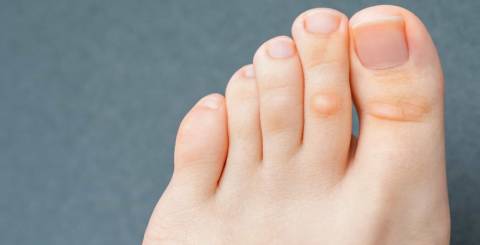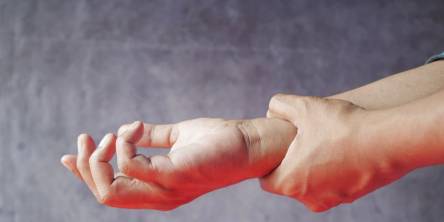What to Know About Corn Removal Surgery

Corn removal surgery may be the right option if you’re ashamed of your corns or dealing with severe pain or discomfort.
Read on to find out more about corns and how you can get rid of them.
What are corns, and how do they develop?
Corns are hard, thickened pieces of skin that typically appear on regions of the foot that do not bear weight, such as the sides, in between, and on top of the toes.
While corns and calluses may be confused, they can be distinguished by their distinct position.
Corns grow on pressure points and are often bulky and nasty.
Calluses, on the other hand, develop on the weight-bearing area of the foot and are flatter, wider, and far less painful than corns.
What common symptoms arise from corns?
Corns are thickened, hardened layers of skin that form when the skin is subjected to extreme friction or pressure.
They typically appear as small, spherical, elevated lumps that have calcified and are surrounded by inflamed skin.
Their core is always hard and surrounded by inflated skin, and they are smaller and deeper than callouses. They can be extremely uncomfortable to touch.
Thickened or hardened patches of skin on the feet or toes; a lump on the skin; flaky, dry skin surrounding the area; and discomfort or tenderness are common symptoms.
When to consider corn removal surgery?
Although conservative treatment measures such as wearing roomier shoes and applying moleskin pads might help treat corns in healthy people who aren't in too much pain, surgery to remove corns may be considered in a few cases.
It is appropriate for persons with diabetes or other circulatory diseases.
Diabetics frequently have poor blood circulation and a loss of sensation, which can make pain difficult to detect and recovery more challenging. Infection might also be caused by a delay in diagnosis.
Surgery may also be the best option for those who are in a lot of discomfort or have trouble keeping up with their usual exercise routines and wearing shoes.
Walking in excruciating agony and anguish is not something anyone should have to deal with.
Corrective surgery should also be considered in cases where a structural deformity on the foot or toes has resulted in the formation of corns or calluses regularly.
Is corn removal surgery painful?
The local anesthesia keeps the area insensitive after surgery for a while. However, the OTC anti-inflammatory drugs can help relieve throbbing, aching, or burning pain.
Elevating the foot above the level of the heart might relieve discomfort, and the surgeon may advise you to do so for at least the first 48 hours after surgery.
Corn removal surgery and recovery process
Corn removal surgery is the last resort after all other methods, such as adjusting shoe wear, cushioning, and shaving the corn, have failed.
If you decide that you need one, try to find and choose the best of at least a few experienced and qualified specialists, instead of Googling “corn removal near me” and choosing the first result in a row.
Surgery is conducted as a brief office-based procedure and performed under local anesthetic. Typically, the process is rapid.
The podiatrist will use a sterile scalpel to shave off the dead skin way down to the root of the corn, which is then removed, after making a small incision (approximately 1 cm).
The deformity is repaired after the corn root is removed.
This will ensure that the corn does not reappear unless the friction, irritation, or pressure against the skin caused by ill-fitting shoes is removed.
The incision is then stitched closed, bandaged, and a surgical shoe is applied.
During the first week after surgery, the patient will also be required to ice and elevate the foot as much as possible.
Corn removal surgery might take anything from 6 weeks to 3 months to fully recover from.
For two weeks after surgery, the patient must wear a postoperative shoe to protect the damaged area, and the dressing must not be damp. A shower bag is frequently used to keep it dry.
Walking without a shoe might result in edema, a longer healing time, and other concerns.
Patients will need to limit their physical activities and avoid wearing conventional shoes, which will help to relieve pressure on their feet and aid in the healing process.
To limit the chance of infection, keep your feet clean and dry during this period.
While stitches can be removed in as little as ten days, everyday activity should be restricted for three weeks following surgery.
Patients will be pleased to witness a dramatic difference in the appearance of their feet once the healing procedure is completed.
Furthermore, being pain-free offers new pathways for joy and fulfillment in everyday activities that were before impossible.
While corns can reappear, they are less likely to do so if people care for their feet according to their doctor's advice.
Similar Articles
Most people think health problems start suddenly. One day you feel fine, the next day something is wrong. In reality, most health issues develop slowly .They grow quietly in the background while life keeps moving.
The start of a new year is a natural time to pause, reflect, and think about how you want to feel in the months ahead. For those over 60, a fresh start does not mean setting unrealistic resolutions or making drastic changes.
Picture this: You're parked at your workspace, battling to focus on what should be a straightforward five-minute task. That afternoon slump? It's demolishing you today.
Joint pain and arthritis are common health issues that tend to become more intense during the winter season
Discover the benefits, challenges, and future of locum medical jobs. Learn how locum recruitment agencies support flexible, diverse career opportunities for healthcare professionals seeking dynamic work environments.
Burnout in the healthcare environment is a significant and growing crisis.
NAD+ therapy restores cellular energy, enhances metabolism, and promotes anti-aging by supporting DNA repair and improved overall vitality.
Seasonal Affective Disorder (SAD) is a type of depression linked to seasonal changes, most commonly seen during the late fall and winter months when sunlight exposure decreases
Enhance sleep comfort and support with a mattress topper queen. Discover how the right topper improves pressure relief, temperature control, and rest.









